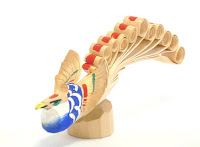Kokeshi-Do
- artisan : Tatsuo Sato
- type : Traditional Yajiro
- tall : 24cm(10inch)
- max width : 7cm(3inch)
What is "DO"(道)?
There is a variety of something-"DO(道)" in Japan - "JU-DO":martial arts,"KA-DO":art of flower arrangement,"Sa-DO":art of tea ceremony,"BUSHI-DO":practical ethics of old warriors,and all the rest. I have even heard "EIGO-DO",that is,"English language-DO".It is proper to translate "DO" as "way" in English because the word "way" has a variety of meanings as much as the word "DO",which includes the meanings originally such as 'route' or 'path',and in expanse,'method' or 'approach' or 'style' or 'manner' etc. And "the way of life" - actually,the word "DO" has the nuance of "dedication".
So, the above "EIGO-DO" is that "you have to completely devote yourself to mastering English!" -one book about it says the following: "Use only English,not Japanese in your daily life, read a copy of TIME more than 100 times, talk to all the foreign people whom you could meet across in the street, and you will master English!" - I often used to go and talk to them in Roppongi, Tokyo according to its precept, but I gave it up later because it cost too much - people who were willing to reply to me were all barkers of "unreasonable" show pub.
Silly talk aside, "DO" itself has discipline or rules - in Kado, Japanese flower arrangement, you have to master much detailed rules - choice of seasonable flower, order of several kinds of flowers, length and angle of branch or flower... these are quite compulsory, so some people leave its lesson, but others who remain say, "these rules have real meaning" - although I'm quite a stranger to Kado, I can understand what they say.
If we want to express sense of the season of tender green as liveliness or vitality, we could choose flowers with rich foliage and make arrangement to emphasize rather its foliage than flowers. But there is a variety of limitation - space limitation or plant trait or something. So, Kado masters have repeated trial and error to express their feelings effectively within limitation -the accumulations of their creative efforts are such detailed rules.
"Limitation" - if we want to purely enjoy flowers or trees, we can just go and see them or we can garden. But the basis of Kado is "to appreciate the sense of the season through plants in a room(usually, "washitsu", a kind of Japanese-style room)". So,many detailed rules -these are also all decoration techniques- underlie this basic standpoint.
Kokeshi-DO
Considering it, kokeshi,especially traditional kokeshi seem to have much limitation - the first is "wooden", the second is "(like) doll ", the third is "with no limbs", the forth is "by using lathe"... these are "intentionally-defined" limitation and even "unwritten" rules. I am really surprised that artisans have followed these rules - if I were an artisan, I would have complained about them -"give me liberty!" - and an old stubborn artisan would say to me, "Do what you should before that!"Then, what's the basic standpoint in crafting kokeshi? After all, I think it is "the craft by wood turning" - however, there is another craft by wood turning -lacquer ware. So,accurately, it is "the craft by wood turning without lacquer". Historically, they have taken pride in their skills - I'll talk about it as a theme of "Kijishi",woodworkers some time.
I think crafting kokeshi is a kind of "DO(道)" in the sense that artisans devote themselves to it. And "DO" is not limited to matters of Japan - whatever people devote themselves to. It doesn't matter whether it has strict formality or not - rather, its extreme formality even leaves people cold in Japan - actually, Sado or Kado are not as popular as they used to be - they used to be much popular as "training for married life" in Japan!
I think one of the reasons is peremptory teaching - basically, "No buts.Do as you are told!" - how many times I heard the word when I practised Judo - But sorry to say, modern Japanese aren't as obedient as old Japanese. So, I think instructors or coaches had better use more explanation in their coaching or training - for example, the reason or meaning of suitable stem length or highly-attractive flower angle or something - if they really want to hand down the value of their tradition. Incidentally, as for my Judo practice, I had obeyed my coach from child as an "old Japanese", but I was just slow to realized "not all men are created equal in talent for sport". Read more...












